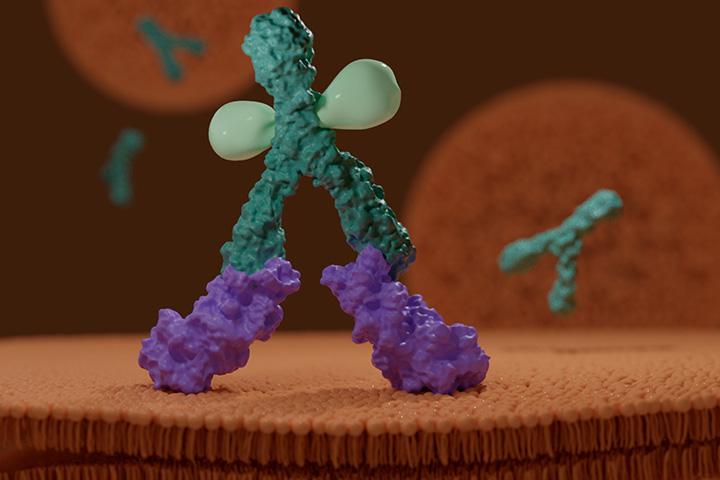There may be a new, more effective method for treating high-risk neuroblastoma, according to scientists at the Children’s Hospital of Philadelphia and collaborators in the Cancer and Inflammation Program at NCI at Frederick.
Together, the groups published a study describing a previously unrecognized protein on neuroblastoma cells, called GPC2, as well as the creation of a novel antibody-drug conjugate, a combination of a human antibody and a naturally occurring anticancer drug, that locates and binds to GPC2 in a highly efficient way.
Identifying unique tumor targets and developing more tumor-specific therapies has become crucial, as most current neuroblastoma treatments, like chemotherapy, are nonspecific and highly toxic. Further, such approaches do not always work, especially in high-risk neuroblastomas where patient survival rates remain low despite aggressive treatments.
D3-GPC2-PBD, a novel antibody-drug conjugate developed at the NCI Cancer and Inflammation Program for the study, is one example of a promising tumor-specific therapy. The antibody—D3—binds to GPC2 on neuroblastoma cells, penetrates the cell membrane, and delivers the anticancer drug—PDB—inside the cell, causing rapid cell death. In the study’s preclinical testing models, small doses of the conjugate administered over a two-week span induced a major reduction in tumor size for over eight weeks after treatment ceased.
“It is [also] highly expected the [antibody-drug conjugate] treatment will cause immunogenic cell death of the cancer cells, which could potentially induce immune responses toward cancer cells,” said study contributor Zhongyu Zhu, Ph.D., staff scientist, Cancer and Inflammation Program.
Those immune responses could lead to a further sustained or accelerated decay in a patient’s tumors, especially when the conjugate is administered alongside drugs that block the body’s natural restrictions on the immune system. The conjugate’s specificity for tumor cells also reduces toxicity in the rest of the patient’s body, decreasing the treatment’s harmful side effects.
To develop the conjugate, a Cancer and Inflammation Program team led by Zhu and Dimiter S. Dimitrov, Ph.D., (retired) head of the program’s Protein Interactions Section, isolated D3 from the program’s recombinant antibody libraries, which contain billions of fully human antibodies. First, a panel of antibodies underwent three rounds of panning against the recombinant human GPC2 protein, and the most promising candidates were selected for functional characterization.
Once the team determined that D3 demonstrated the highest affinity and binding specificity, they produced the finalized conjugate by purifying the antibody and joining it with pyrrolobenzodiazepine, a natural anticancer compound found in a group of soil-dwelling bacteria.
However, the program’s researchers emphasize that the technology platform behind the development of D3-GPC2-PBD is more important than the conjugate itself, as the same platform also aided in the development of an antibody-drug conjugate that targets CD276/B7-H3, another protein common in many tumors. By attaching the drug directly to a carbohydrate on the antibody instead of its peptide backbone—a method unique to this technology—the platform creates a more uniform and stable product that could be safer and more effective for clinical use.
The study also investigated potential targets for therapy. Children’s Hospital of Philadelphia led the research that identified GPC2 as a candidate, conducting tests that confirmed its high occurrence on neuroblastoma cells, its role in driving neuroblastoma tumor development and growth, and its lack of occurrence on healthy cells elsewhere in the body. These attributes make it a promising subject for both D3-GPC2-PBD therapy and other immunotherapies.
The Philadelphia team further confirmed that GPC2 occurs on tumor cells in other high-risk childhood cancers, including medulloblastoma and retinoblastoma, indicating that they could also be treated with GPC2-targeted therapy. The Cancer and Inflammation Program’s novel platform for creating site-specific antibody-drug conjugates—a current focus of Zhu and collaborators—could therefore be used to produce highly effective compounds to treat those cancers, as well.
“Very promising immunotherapeutic approaches [against GPC2] have been developed and well-validated,” said Zhu. “This study will potentially benefit pediatric cancer patients, for whom innovative and effective therapy is desperately needed.”


